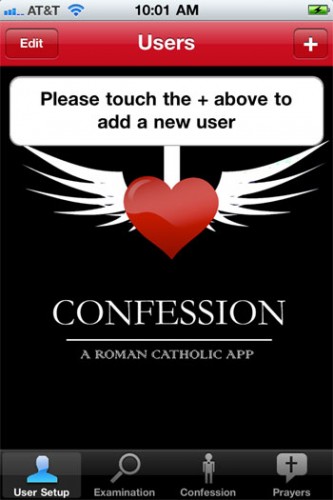 All together now, let's recite the W5H journalism creed.
Who. What. When. Where. Why.
All together now, let's recite the W5H journalism creed.
Who. What. When. Where. Why.
And How.
I'm still thinking about that last one, in terms of some of the hilariously bad coverage that we saw the other day of that Confession app that was written for the iPad, iPhone and the iPod Touch. You may recall that the stated purpose of this app was to provide a kind of digital Guide For Confession -- by which I mean those printed leaflets that believers have used for generations to help guide them in an examination of conscience before going to confession.
The problem, of course, is that many news organizations could not resist the sexy headline or the nut graph that claimed people were going to be able to confess TO their iWhatever or through their iWhatever -- thus contradicting the written materials about the app or, for those who took the trouble to invest $1.99 and download the software, its actual contents.
Here's a reminder of what happened next, care of my Scripps Howard News Service column on the affair:
"Bless me father for I have sinned. It has been 300 tweets since my last confession," noted CNN.
In London, The Times opened its story by claiming: "Roman Catholic bishops have approved a new iPhone and iPad app that allows users to make confession with a virtual 'priest' over the Internet."
Note the phrase "over the Internet." Let's continue:
The Economic Times report was even more blunt. The headline noted, "No time to visit church? Confess via iPhone." Then the opening lines went further still, stating: "Users of iPhone can now perform contrition and other religious rituals without visiting church, thanks to a new online application."
The problem is that these statements were just plain wrong. There is no such thing as a "virtual" priest or a "virtual" sacrament. How could electronic devices allow believers to "perform ... other religious rituals"? ...
(The) the cracked headlines rolled on with the Catholic League expressing outrage about new stinkers, such as, "Can't Make it to Confession? There's an App for That," "New, Church-Approved iPhone Offers Confession On the Go" and "Bless Me iPhone for I Have Sinned."
Now, note the phrases "without visiting church" and "church-approved."
 Having royally messed up this story, some journalists then had the nerve to report -- when Roman Catholic officials issued statements objecting to the misinformation in the press -- that the Vatican had withdrawn its support for the app that supposedly let you do things that the makers of the app never claimed that it allowed you to do in the first place. Or something like that. It was a perfect circle of errors. Catch-22.
Having royally messed up this story, some journalists then had the nerve to report -- when Roman Catholic officials issued statements objecting to the misinformation in the press -- that the Vatican had withdrawn its support for the app that supposedly let you do things that the makers of the app never claimed that it allowed you to do in the first place. Or something like that. It was a perfect circle of errors. Catch-22.
I bring this up because of something that hit me just before we recorded this week's Crossroads podcast. Click here to listen to that or to download it (or head on over to get a copy at iTunes).
In your mind's eye, travel back to the beginning of this liturgical train wreck and put yourself in the shoes of the journalists who wrote the headlines and reports that started this mess.
Ready? Now ask yourself this elementary journalistic question: "How?"
As in the "how" in the W5H formula. How did these journalists think that these penitents were going to confess through their iPhones, iPads, etc.? Surely each of these journalists had to think about that before writing his or her story or headline.
Picture the scene in your mind. What were the believers going to do? Confess by talking to a priest? They could do that already by telephone, if the church allowed that to happen. Text in their confession? Tweet it? Peck out a confession in an email, line after line, which would then go into a priest's in-box for a later response through the same medium? Folks could already do that through computers and existing forms of software, again, if the ancient churches allowed that to happen.
There's another angle to this: Hadn't any of the journalists who touched these stories ever been to Confession?
I mean, surely there was someone, at least one individual, in each of these newsrooms who was a fully practicing, sacramental believer in a Catholic or Orthodox parish. Newsrooms are supposed to be built on the concept of diversity, right? Surely there was someone in these newsrooms who knew the drill, someone who knew what actually happens in Confession. Don't you think? What did the editors in these newsrooms think was going to happen in these "virtual" confessions?
I never found a story that answered that "how" question.
How about you, GetReligion readers? Did you see that in any story or hear that question answered in broadcast reports?
D'oh. I can't believe that I didn't think question of that earlier.
